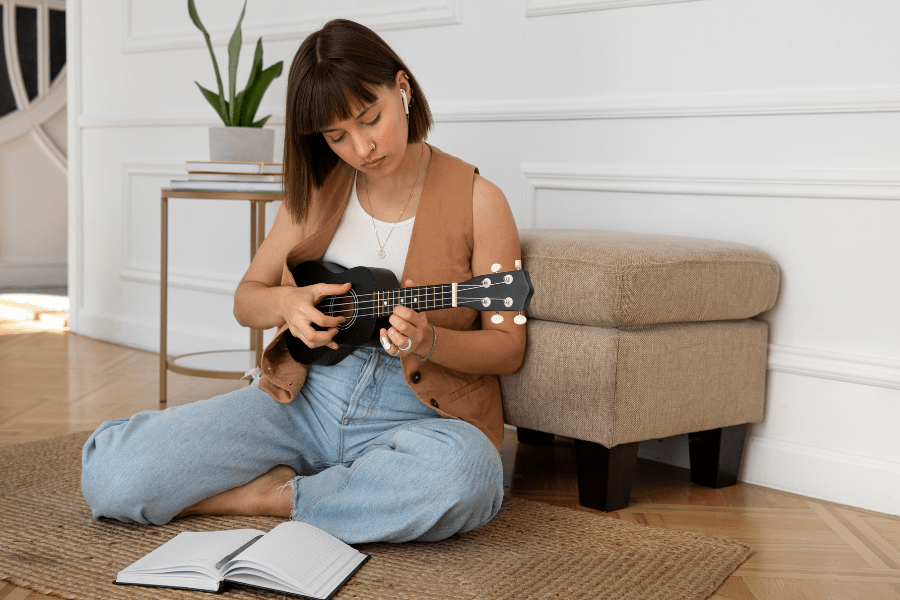Condominium living demands mindful, pleasing living conditions, taking into account noise-sensitive areas and respectful neighbors. To ensure satisfaction, use simple instruments and keep an enjoyable environment.
Musical instruments you can learn in your condo without bothering your neighbors:
Living in a condo often requires consideration for noise levels, especially when playing musical instruments. Here are nine quiet musical instruments that are suitable for condo living:
Electric Keyboard
An electric keyboard allows musicians and you to use headphones, eliminating any external noise. It’s a versatile instrument that can mimic the most even sound effects of various instruments.
Electric Guitar
Similar to an electric keyboard headphone amp, an electric guitar can be played with headphones, minimizing the noise. You can enjoy playing your guitar without disturbing your neighbors.
Silent Violin
A silent violin is new instrument designed to be played with headphones. It produces a soft tone of sound electronically, making it an excellent option for practicing your music without bothering others.
Silent Brass Instruments
Various brass instruments, such electric instruments such as trumpet, trombone, and French horn, have “silent” versions available. These electric instruments use special mutes and allow you to play quietly with headphones.
Electronic Drum Kit
Electronic drum kits come with volume control and the ability to play with headphones. You can enjoy acoustic sound while playing the drums at loud, without causing excessive noise.
Ukulele
The ukulele is a small, quiet instrument with strings that produces soft tones. It’s compact and easy to learn, making it an ideal choice for musicians and for condo living.
Bamboo Flute
The bamboo flute instrument produces soothing sounds and is relatively quiet compared to other wind instruments. It’s a simple instrument to play and doesn’t require much space.
Kalimba
The kalimba, also known as a toy piano or a thumb piano, is a small instrument with metal keys. It produces gentle melodies and doesn’t create loud sounds, making many musicians make it suitable for condo environments.
Digital Wind Controller
A digital wind controller, such as the Yamaha WX5, allows you to play various wind instrument sounds using a breath sensor. It can be played with headphones, ensuring quiet in practice space.
Other Instruments you can consider learning at the comfort of your home:
Electric Violin
Playing a quiet electric violin in a condo can be an excellent option for minimizing the sound while still being able to practice and enjoy your instrument. Here are some considerations when playing a quiet electric violin in a condo:
- Electric violin selection: Choose an electric violin model known for its quietness. Some electric violins are designed to produce a softer and more muffled sound compared to acoustic violins. Research and try out different models to find one that suits your needs.
- Volume control: Electric violins often have built-in volume controls or headphone outputs. Utilize these features to adjust the volume to a level that won’t disturb your neighbors. When practicing, consider using headphones to completely eliminate any external sound.
- Soundproofing: Although electric violins produce less sound compared to acoustic violins, soundproofing can still be beneficial in further reducing any residual noise. Use sound-absorbing materials such as acoustic panels, rugs, or curtains in your practice area to minimize sound transmission.
- Time restrictions: Even with a quiet electric violin, be mindful of the time restrictions set by your condo. Respect quiet hours and avoid practicing during periods when noise should be kept to a minimum, particularly in the evenings and early mornings.
- Communication with neighbors: Inform your neighbors about your electric violin and its quiet nature. Let them know that you are taking steps to minimize any disturbance. Discuss your practice schedule with them and ask if there are any specific times that would be less inconvenient for them.
- Practice duration and frequency: To be considerate to your neighbors, break up practice sessions into shorter intervals. Frequent, shorter practices are generally more tolerable than long, continuous sessions. Use headphones to practice, especially during late hours or when others might be sensitive to noise.
- Maintenance and adjustments: Ensure your electric violin is properly maintained and adjusted. Regularly check and maintain the instrument’s components, such as the strings, to minimize any unwanted noises or vibrations.
- Additional noise reduction measures: Consider using a practice mute or a dampening device specifically designed for electric violins. These accessories can further reduce the volume and resonance of the instrument.
Piano (with the quiet pedal)
If you’re playing a piano with a quiet pedal (also known as a practice pedal or a soft pedal), it can help reduce the volume and intensity of the sound produced. Here are some additional considerations when playing quiet instruments for apartments like piano in a condo:
- Placement: Position the piano away from shared walls or near soundproofed areas. This can help minimize sound transmission to neighboring units. If possible, place the piano against an interior wall rather than an exterior wall, as exterior walls tend to transmit sound more easily.
- Soundproofing: Soundproofing options, such as acoustic panels or rugs, can be used to reduce sound transmission around the piano. Additionally, placing a thick rug or soundproofing mat under the piano can help dampen the sound that reaches the floor below.
- Time restrictions: Even with a quiet pedal, it’s still important to be mindful of the time restrictions in your condo. Check if there are specific hours during which noise is expected to be minimized and avoid playing during those times, especially in the evenings and early mornings.
- Communication with neighbors: It’s important to inform your neighbors about your intention to play the piano with a quiet pedal and take steps to minimize noise. Discuss your practice schedule with them and ask if there are any specific times that would be more convenient for them.
- Practice duration and frequency: Practice sessions should be broken up into shorter, more frequent intervals to minimize the impact of the sound on your neighbors. If possible, use headphones with your quiet piano to practice without generating any external sound.
- Volume control: While the quiet pedal reduces the volume, be mindful of the intensity at which you play. Keep your playing at an appropriate level for a residential setting, even with the pedal engaged. Pay attention to dynamics and avoid playing forcefully, as it can still generate some sound.
- Regular maintenance: Ensure that your piano is in good condition and properly maintained. A well-maintained piano is less likely to produce excessive noise or mechanical issues that could be disruptive to your neighbors.
String Family
Within the whole range of the string family, one of the quieter instruments is the electric cello or electric violin. These instruments can be played with headphones or connected to an amplifier with volume control, allowing you to control the sound level.
They produce less acoustic sound compared to their traditional acoustic counterparts, making them suitable for playing in a condo environment without disturbing others.
However, it’s worth noting that electric guitar even acoustic violins or cellos can be played softly with proper technique and the use of a practice mute, which can help reduce the sound effects and volume.
Woodwind Instruments
Woodwind instruments generally have a pretty full range of quiet and wide range of sound dynamics, but there are a few options that can be played more quietly:
- Flute with a Practice Mute: Flutes produce a bright and clear sound, but you can reduce the volume by using a practice mute. This device is inserted into the flute’s headjoint and dampens the sound while maintaining the instrument’s playing characteristics.
- Piccolo: The piccolo is a smaller version of the flute and naturally produces a higher pitch. Due to its size, it tends to be quieter than the regular flute, making it a suitable option for practicing in a condo.
- Clarinet with a Practice Mute: Similar to the flute, the clarinet can also use a practice mute to reduce the volume. The mute can be inserted into the bell of the clarinet to dampen the sound while you practice.
- Silent Clarinet: Some manufacturers offer silent clarinet models that allow you to play using headphones. These quietest instruments are designed to produce sound electronically, providing a quiet practice option.
- EWI (Electronic Wind Instrument): The EWI is a modern electronic wind controller that simulates the sound of various woodwind instruments. It allows you to play with headphones, making it a suitable choice for practicing woodwind techniques quietly.
When playing instruments in a condominium, it’s important to consider the following factors:
1. Noise restrictions
Condos typically have rules and regulations regarding noise levels to maintain a peaceful environment for all residents. Ensure that you are aware of the specific noise restrictions in your condo and adhere to them while playing your instrument.
2. Time restrictions
Some condos may have specific hours during which noise is expected to be kept to a minimum, especially during evenings and early mornings. Be mindful of these time restrictions and avoid practicing your instrument during prohibited hours.
3. Soundproofing
Consider investing in soundproofing measures to minimize the noise that reaches your neighbors. This could include using sound-absorbing materials, acoustic panels, or rugs to help dampen the sound. Additionally, you can isolate output sound from your instrument by playing in a room that is away from shared walls.
4. Communication with neighbors
Communicate with your neighbors about your intention to practice quietly in the condo. Share your practice schedule and ask if they have any concerns or time preferences. Building good relationships with your neighbors can help maintain a harmonious living environment.
5. Use of electronic instruments or headphones
If possible, consider using electronic instruments that can be played with headphones. This allows you to practice quietly without disturbing others. Electronic drums upright bass, keyboards, or electric guitars with headphone outputs can be great alternatives to acoustic instruments.
6. Practice duration and frequency
Be mindful of the duration and frequency of your practice sessions. Shorter, more frequent practice sessions are generally more considerate than long, uninterrupted sessions. Breaking up your practice into smaller increments throughout the day can help minimize the impact on your neighbors.
7. Instrument placement
Position your acoustic instrument well away from shared walls or near soundproofed areas to minimize sound transmission. Avoid placing your instrument near windows or balconies, as the sound of acoustic instruments can easily escape to neighboring units.
8. Volume control
Pay attention to the volume at which you play your musical instrument. Keep it at a level that is appropriate for a residential setting and try to avoid playing musical instruments at excessive volumes that could disturb others.
9. Consideration for the quietest instruments or instruments
If you play a quieter instrument, such as a flute toy piano or violin, you may still need to be mindful of the proximity of your neighbors. While these instruments may be less likely to cause disturbances, it’s important to be considerate of those who may still be sensitive to any noise.





